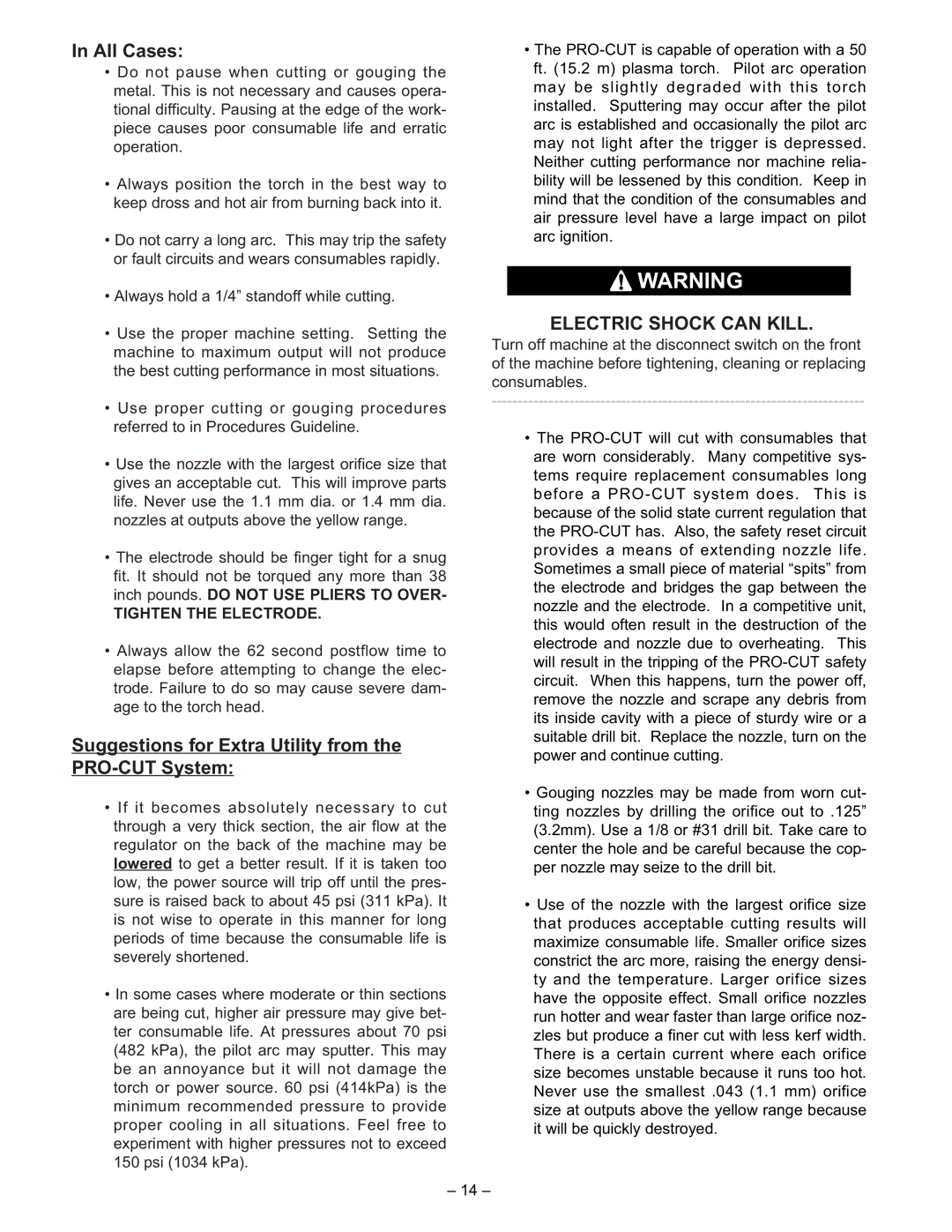In All Cases:
•Do not pause when cutting or gouging the metal. This is not necessary and causes opera- tional difficulty. Pausing at the edge of the work- piece causes poor consumable life and erratic operation.
•Always position the torch in the best way to keep dross and hot air from burning back into it.
•Do not carry a long arc. This may trip the safety or fault circuits and wears consumables rapidly.
•Always hold a 1/4” standoff while cutting.
•Use the proper machine setting. Setting the machine to maximum output will not produce the best cutting performance in most situations.
•Use proper cutting or gouging procedures referred to in Procedures Guideline.
•Use the nozzle with the largest orifice size that gives an acceptable cut. This will improve parts life. Never use the 1.1 mm dia. or 1.4 mm dia. nozzles at outputs above the yellow range.
•The electrode should be finger tight for a snug fit. It should not be torqued any more than 38 inch pounds. DO NOT USE PLIERS TO OVER-
TIGHTEN THE ELECTRODE.
•Always allow the 62 second postflow time to elapse before attempting to change the elec- trode. Failure to do so may cause severe dam- age to the torch head.
Suggestions for Extra Utility from the PRO-CUT System:
•If it becomes absolutely necessary to cut through a very thick section, the air flow at the regulator on the back of the machine may be lowered to get a better result. If it is taken too low, the power source will trip off until the pres- sure is raised back to about 45 psi (311 kPa). It is not wise to operate in this manner for long periods of time because the consumable life is severely shortened.
•In some cases where moderate or thin sections are being cut, higher air pressure may give bet- ter consumable life. At pressures about 70 psi (482 kPa), the pilot arc may sputter. This may be an annoyance but it will not damage the torch or power source. 60 psi (414kPa) is the minimum recommended pressure to provide proper cooling in all situations. Feel free to experiment with higher pressures not to exceed 150 psi (1034 kPa).
•The
![]() WARNING
WARNING
ELECTRIC SHOCK CAN KILL.
Turn off machine at the disconnect switch on the front of the machine before tightening, cleaning or replacing consumables.
•The
•Gouging nozzles may be made from worn cut- ting nozzles by drilling the orifice out to .125” (3.2mm). Use a 1/8 or #31 drill bit. Take care to center the hole and be careful because the cop- per nozzle may seize to the drill bit.
•Use of the nozzle with the largest orifice size that produces acceptable cutting results will maximize consumable life. Smaller orifice sizes constrict the arc more, raising the energy densi- ty and the temperature. Larger orifice sizes have the opposite effect. Small orifice nozzles run hotter and wear faster than large orifice noz- zles but produce a finer cut with less kerf width. There is a certain current where each orifice size becomes unstable because it runs too hot. Never use the smallest .043 (1.1 mm) orifice size at outputs above the yellow range because it will be quickly destroyed.
– 14 –
